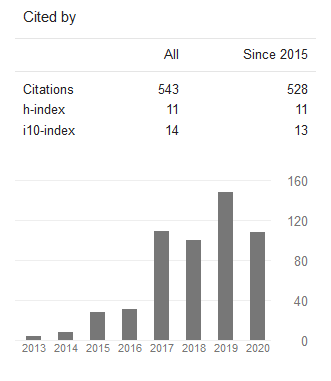Kombinasi Sinyal EEG dan Giroskop untuk Kendali Mobil Virtual dengan Menggunakan Modifikasi ICA dan SVM
DOI:
https://doi.org/10.24002/jbi.v7i3.655Abstract
Abstract. Electroencephalogram (EEG) signals has been widely researched and developed in many fields of science. EEG signals could be classified into useful information for the application of Brain Computer Interface topic (BCI). In this research, we focus in a topic about driving a car using EEG signal. There are many approaches in EEG signal classification, but some approaches do not robust EEG signals that have many artifacts and have been recorded in real time. This research aims to classify EEG signals to obtain more optimal results, especially EEG signals with many artifacts and can be recorded in realtime. This research uses Emotiv EPOC device to record EEG signals in realtime. In this research, we propose the combination of Automatic Artifact Removal (AAR) and Support Vector Machine (SVM) which has 71% of accuracy that can be applied to drive a virtual car.
Keyword: EEG signal classification, automatic artifact removal, brain computer interface
Abstrak. Penelitian berbasis sinyal Electroencephalogram (EEG) telah banyak diteliti dan dikembangkan pada berbagai bidang ilmu pengetahuan. Sinyal EEG dapat diklasifikasikan ke dalam bentuk informasi untuk pengaplikasian topik Brain Computer Interface (BCI). Pada penelitian ini difokuskan pada topik pengendalian mobil menggunakan perintah sinyal EEG. Terdapat beberapa pendekatan dalam klasifikasi sinyal EEG, tetapi beberapa pendekatan tersebut tidak robust terhadap sinyal EEG yang memiliki banyak artefak dan direkam secara realtime. Penelitian ini bertujuan untuk mengklasifikasikan sinyal EEG dengan hasil lebih optimal, khususnya pada sinyal EEG yang memiliki banyak artefak dan direkam secara realtime. Penelitian ini menggunakan perangkat Emotiv EPOC untuk merekam sinyal EEG secara realtime. Pada penelitian ini diusulkan kombinasi Automatic Artifact Removal (AAR) dan Support Vector Machine (SVM) yang menghasilkan hasil akurasi sebesar 71% untuk klasifikasi sinyal EEG pada kasus pengendalian mobil virtual.
Kata Kunci: EEG signal classification, automatic artifact removal, brain computer interface
References
. Alomari, M. H., Abubaker, A., Turani, A., Baniyounes, A. M., & Manasreh, A. 2014. EEG Mouse: A Machine Learning-Based Brain Computer Interface.IJACSA) International Journal of Advanced Computer Science and Applications, 5(4), 193-198.
. Bertrand, A., & Moonen, M. 2014. Distributed eye blink artifact removal in a wireless EEG sensor network. In 2014 IEEE International Conference on Acoustics, Speech and Signal Processing (ICASSP) (pp. 5849-5853). IEEE.
. Burges, C. J. 1998. A tutorial on support vector machines for pattern recognition. Data mining and knowledge discovery, 2(2), 121-167.
. Chang, C. C., & Lin, C. J. 2011. LIBSVM: a library for support vector machines. ACM Transactions on Intelligent Systems and Technology (TIST),2(3), 27.
. Damayanti, F., Arifin, A. Z., & Soelaiman, R. 2010. Pengenalan citra wajah menggunakan metode two-dimensional linear discriminant analysis dan support vector machine. Jurnal Ilmiah Kursor, 5(3), 147-156.
. Golz, M., Sommer, D., Trutschel, U., Krajewski, J., & Sirois, B. (2013). Driver Drowsiness Immediately before Crashes–A Comparative Investigation of EEG Pattern Recognition. In 7th International Driving Symposium on Human Factors in Driver Assessment, Training, and Vehicle Design (No. 78).
. Hsu, C. W., & Lin, C. J. 2002. A comparison of methods for multiclass support vector machines. IEEE transactions on Neural Networks, 13(2), 415-425.
. Lenc, L., & Král, P. 2015. Automatic face recognition system based on the SIFT features. Computers & Electrical Engineering, 46, 256-272.
. Liang, Q., & Mendel, J. M. 2000. Interval type-2 fuzzy logic systems: theory and design. IEEE Transactions on Fuzzy systems, 8(5), 535-550.
. Nguyen, T., Khosravi, A., Creighton, D., & Nahavandi, S. 2015. EEG signal classification for BCI applications by wavelets and interval type-2 fuzzy logic systems. Expert Systems with Applications, 42(9), 4370-4380.
. O’Regan, S., Faul, S., & Marnane, W. 2013. Automatic detection of EEG artefacts arising from head movements using EEG and gyroscope signals.Medical engineering & physics, 35(7), 867-874.
. Sugeng, R., & Agus, P. 2009. Algoritma Fast Fourier Transform (FFT) Decimation in Time (DIT) dengan Resolusi 1/10 Hertz. In Seminar Nasional Penelitian, Pendidikan, dan Penerapan MIPA 2009.
. Suk, H. I., & Lee, S. W. 2013. A novel Bayesian framework for discriminative feature extraction in brain-computer interfaces. IEEE Transactions on Pattern Analysis and Machine Intelligence, 35(2), 286-299.
. Sun, H., Bi, L., Chen, B., & Guo, Y. 2015. EEG-based Safety Driving Performance Estimation and Alertness Using Support Vector Machine.International Journal of Security and Its Applications, 9(6), 125-134.
. Vysata, O., Kukal, J., Prochazka, A., Pazdera, L., Simko, J., & Valis, M. 2014. Age-related changes in EEG coherence. Neurologia i neurochirurgia polska, 48(1), 35-38.
. Welch, P. D. 1967. The use of fast Fourier transform for the estimation of power spectra: A method based on time averaging over short, modified periodograms. IEEE Transactions on audio and electroacoustics, 15(2), 70-73.
. Zhao, C., Zheng, C., Zhao, M., Liu, J., & Tu, Y. 2011. Automatic classification of driving mental fatigue with EEG by wavelet packet energy and KPCA-SVM. Int. J. Innov. Comput. Control, 7(3), 1157-1168.
Downloads
Published
Issue
Section
License
Copyright of this journal is assigned to Jurnal Buana Informatika as the journal publisher by the knowledge of author, whilst the moral right of the publication belongs to author. Every printed and electronic publications are open access for educational purposes, research, and library. The editorial board is not responsible for copyright violation to the other than them aims mentioned before. The reproduction of any part of this journal (printed or online) will be allowed only with a written permission from Jurnal Buana Informatika.
This work is licensed under a Creative Commons Attribution-ShareAlike 4.0 International License.









